
NISSAN GT-R
Generations Timeline, Specs and Pictures
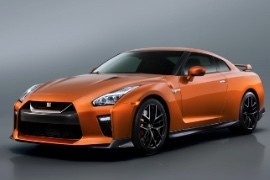
The iconic Nissan GT-R R35 was launched at the Tokyo Motor Show in 2007 as a 2009 model and it received further updates.
The 2017 version received a new interior and 20 hp more than before.
The Japanese car-manufacturer Nissan built the GT-R name over the years and, in 2007, it showed the R35, which was offered for the first time with both left and right-hand drive. The car was so advanced, that it stole the crown of Nurburgring King from the Porsche 911 Turbo. But the evolution had to continue.
The 2017 version was based on the same Nissan Midship Premium platform and its shape was almost the same as 10 years before. The Nissan designers couldn’t do something better than that, or they didn’t have the budget to do it. But they did what they could to enhance both the look and the performances. For the outside, there was a new front bumper installed, with new air-scoops on the sides and, inside the scoops, there was the DRL.
Major improvements were made inside the cabin. The GT-R was meant to be both comfortable and fast. But the luxury was not a key element in the process. In 2016, the designers fixed that. The redesigned cabin featured a premium interior, to fit the high-performance sports car. The dashboard was new, with an instrument panel wrapped in a single, seamless piece of hand-selected Nappa leather. On the center console, the car featured a new 8” touch-screen infotainment system that could connect to Apple CarPlay.
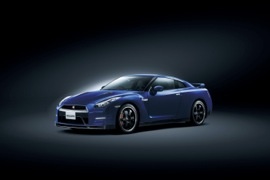
When Nissan unveiled the car at the Tokyo Auto Show in 2007, the car enthusiast world was set on fire.
The look of the car and the on-paper specs were in the super-cars league, but at half the price.
The history of the GT-R badge goes back in time to the ’60s, when it was used by Prince, a former Japanese name that merged with the Datsun-Nissan. Over time, the cars that wore the Skyline GT-R badges became more and more powerful and with the addition of the ATESSA E-TS all-wheel-drive system, it was even faster.
The 2007 GT-R lost the “Skyline” name but it offered the expected performances. It could stay side-by-side with cars like Ferrari F430, Porsche Turbo or Lamborghini Gallardo. In 2011, the facelift brought more power and a better look for the vehicle. The front bumper included the LED daytime running lights and in the rear, a new diffuser was installed to improve the air-flow underneath the car. Bigger wheels with new designs were installed.
On the inside, the car-maker improved the material’s quality and the infotainment system. Like before, it was used for measuring various car performances and also for the audio and navigation system. The 2011 model featured an iPod connectivity and USB port in addition to the HDD installed. It featured a Bose sound system.
The twin-turbo V6 engine was upgraded from 500 hp in 2009 to 530 in 2012 and up to 545 in 2016 But since the engine was hand-built, each car had a different real power. The Nissan stated the least power a car would offer.
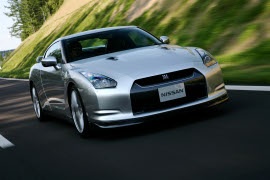
The GT-R badge was used for the first time in 1969 when Nissan released the 2.0-liter Nissan Skyline.
The Nissan GT-R R35 was presented at the Tokyo Motor Show in 2007 and entered the European market one year later.
The all new GT-R’s engine was hand-built by only 4 mechanics that were specially trained to do this.
The engines were a 6-cylinder twin turbo V6 with 480 hp that rocketed the GT-R to 100 kph in just 3.6 seconds. And guess what, it only took 37 meters for the car to come to a full stop. The car had a top speed of 193 mph.
The supercar had a dual-clutch transmission that was based on the Formula 1 technology. The GT-R was offered with an electronically controlled all-wheel-drive.
With all its characteristics pointing to a track car, Nissan let the buyers know that the GT-R is suitable for different types of roads and could be driven by anyone due to its automatic transmission, and moreover, it had no problem being in the traffic. It had a reduced fuel consumption if the Race mode was not activated.
The exterior design indicated a heavy, muscular car – which was true – but was designed with an extreme attention to every line, and even the side mirrors were built to channel the air to the rear spoiler.
A supercar is expected to perform impeccably while high-speed-cornering, but the GT-R was extremely fast in straight lines as well.
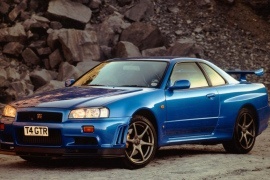
There are not many cars built in Japan that gathered so much attention such as the Nissan Skyline GT-R R34.
And the 1999 V-Spec was even better.
The Skyline GT-R started its career way back in the ’60s. But the real evolution of the model started in 1989 with the introduction of the third-generation R32. That generation saw the introduction of the ATTESA E-TS all-wheel-drive system, which will define the future GT-R models in the future, including the R34.
In 1999, Nissan launched the fifth generation of the Skyline GT-R. Right from the beginning, it also introduced the V-Spec version. From the outside, it had some specific details. There were more air-intakes in the front bumper then were the extracting air-scoops on the hood and in the upper back of the front fenders. The widened body with flared fenders was part of the Nissan GT-R design cult. In the rear, on the trunk, there was a carbon-fiber adjustable wing. A carbon-fiber diffuser was installed in the back. For the cars imported in the U.K., full underbody diffusers were installed.
Inside, there were two bucket-seats in the front with high bolstered sides. In the rear, there were two seats installed. The special TFT screen on top of the center console was showing various car statuses such as the boost pressure, G-Force (for acceleration, braking and side). The V-Spec added the temperature for the intake and exhaust gas.
From the performance point of view, the ATESSA E-TS Pro system was different than on the other GT-R versions. The limited-slip differential in the back was electronically controlled to improve traction, unlike the mechanical differential on the GT-R. The V-Spec also had a firmer suspension than the regular version.
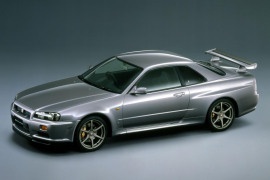
It is a cult-car, the vehicle that made the European sports cars looks outdated.
The history of Skyline goes back in time since 1957 under the brand Prince. Fast forward to 1999 and we found the R34. A car that wrote history in the Skyline R34. A coupe packed with the latest technology on the market and an advanced engine: the RB26DETT. It featured a twin-turbo, individual throttle body for all the six pistons, water-cooled ceramic turbochargers with ball-bearings and the list can go on.
The Skyline R34 had an intelligent all-wheel-drive system with a limited-slip rear differential (LSD), which helped the car accelerate faster on the corner’s exits. An important feature of the car was the Multi-Function-Display (MFD) that was mounted on the dashboard. This display showed many of the car’s engine stats including boost pressure, oil temp, water temp and more. As a 1999 car, this kind of technology was very rare and advanced at the time.
The stated power output of the engine was 280 hp, as part of a gentleman agreement between the Japanese car-manufacturers to not advertise more power than that. But in reality, the car was dyno-ed at 330 hp. Due to its cast-iron engine block and forged internals, it supported many modifications and some were modified to offer over 1000 hp.
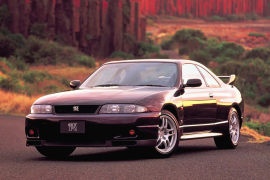
In 1995, Nissan introduced the fourth generation Skyline GT-R, also known as the R33.
The new car used the same RB26DETT engine from the R32. It mainly tried and succeeded in improving on the previous model. It featured improved computer parameters for the ATTESA-ETS all-wheel drive system and Super HICAS four-wheel steering concept. The power output was officially claimed as 280 hp, but in fact it was 302 hp. The R33 was longer and wider than its predecessor and introduced minor visual changes both on the inside and outside. The Skyline GT-R R33 came standard with Brembo brakes and as of 1995 with standard airbags.

The V-Spec was launched by Nissan synchronous with the Skyline GT-R in January 1995.
The “Victory Specification” version of the R33 was 10 kgs (22 lbs) heavier than the normal GT-R and featured the ATTESA-ETS Pro all-wheel drive system. The ATTESA-ETS Pro introduced an active limited slip differential for the rear wheels and also controlled the ABS independently an all four wheels. The V-Spec version featured sportier suspension and lowered the car by 10 mm, improving the car’s handling. Again the official power rated the car with 280 hp, but the real output was recorded at 302 hp.
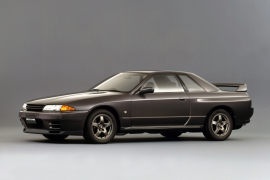
The Nissan Skyline R32 was part of a long-range of performance vehicles made in Japan.
The GT-R was introduced in 1989 after a long break.
In 1973, Nissan axed the Skyline GT-R performance model from its lineup. The times of oil crisis were on and the car manufacturers had to focus more on economy cars and the GT-R was not even close. But the Japanese car-manufacturer revived the GT-R name in 1989. It was designed to dominate the Group A class racing. But, to put the car on the starting grid, it had to build the series model.
The bodywork was a sleek, two-door coupe. To fully comply with the regulations, the car had to be fitted with wider tires. That was why the fenders were enlarged, giving the car a more aggressive stance. A short trunk lid and a spoiler on it completed the car’s silhouette. For the headlights, Nissan chose to go wit square looking elements, that were easier to repair if any damage occurred on the racetrack. The rear taillights were rounded and carried over from the regular, 4-door Skyline.
Inside, the car featured four seats but only for insurance purposes. The rear legroom was not so important, especially for the race version that was fitted with only the driver’s seat. A simple dash design with straight-forward lines and a 6-dials instrument cluster was adopted. A particular gauge was on the top right side of the instrument cluster showed the torque sent to the front wheels.
The engine was an inline-six unit with a 2.6-liter displacement and twin-turbo. The all-wheel-drive system was new and it was specially developed for racing.
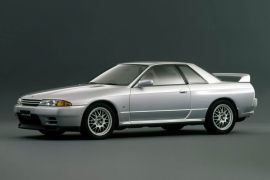
After successfully introduced the R32 series, Nissan built a special version to get a homologation to race the vehicle in various championships.
Nissan introduced the Skyline R32 in 1989 to compete in the Group A racing series in Japan and other countries where it dominated the race-tracks. In fact, it demolished its competitors in Australia until the race-rules were changed and banned all-wheel-drive vehicles from Group A. The same story was applied for Audi in the U.S. The GT-R V-Spec version was the one that brought more joy for the drivers. Nissan built only 2800 units of the V-Spec version.
There was a different skirt at the front and a different wing in the back on the outside. For the V-Spec version, Nissan installed 17” light-alloy-wheels with a specific, twin five-spoke design. Its side skirt was wider than on a regular GT-R, and the rear flared wheel-arches made the car wider. It managed to stay inside the same overall dimensions as the regular version due to the door-mirrors.
Inside, the car featured a pair of race-bucket seats with integrated headrests and passage-through for a four-point harness, even though the carmaker sold the car with regular, three-point seatbelts. In the back, it was the standard bench profiled for two passengers. In the instrument cluster, Nissan installed a gauge showing the amount of torque sent to the front wheels.
Under the hood, the V-Spec featured the same RB26, twin-turbo engine. It was officially rated at 276 hp, but in reality, all of them were making over 300. Otherwise, it was hard to believe that the car could do a 0 to 60 mph (0-100 kph) run in less than five seconds.
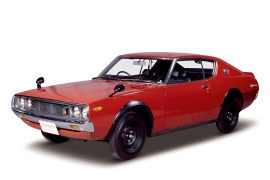
Nissan produced the second generation of the Skyline GT-R in 197 units before it cut it from the assembly lines due to newer emission standards.
Nissan unveiled the C110 Skyline at the 1972 Tokyo Motor Show, but the sales started next year. It was a big gamble with the Japanese rules and regulations, which the carmaker lost. It was the last GT-R until the 1989 model, the mighty R32.
Unlike its predecessor, the C110 featured a fastback coupe shape. Shinichiro Sakurai designed the car as a sport vehicle. It was no longer a two-door version of a sedan. He took his inspiration from American and European sports cars from those times. The front fascia sported a dual-headlights system, with four headlamps in individual clusters. Nissan didn’t put its name on the mesh-grille and left only the black and red GT-R badge. From its side, the car resembled the fastback shape of the Mustang Mach 1, with a similar window line but scaled down. Its back panel sported only the Skyline nameplate but not the company’s logo.
Inside, the carmaker installed two bucket seats at the front separated by a center console with a storage compartment. In the back, even though there was a bench, it was suitable only for children or small dogs. The instrument cluster featured an aluminum panel and seven clusters for the dials and gauges.
Under the hood, Nissan installed a masterpiece, inline-six engine. Its two-liter displacement provided 160 hp, and it was fed through three double-barrel horizontal carburetors. It was the exact solution adopted by some European racing cars from that era. A five-speed manual sent the power to the rear wheels. The GT-R featured disc brakes in all corners, which was unusual for a Japanese car.
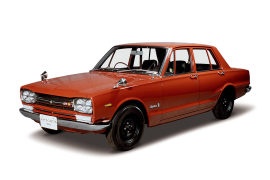
In 1966, Nissan bought the small Japanese company named Prince, that had a long history in motor racing.
And together they developed a special, four-door sedan: it was the Skyline GT-R.
The Prince company tried to win over the Porsche 904 but they failed in 1964. In 1965 Prince developed a special, mid-engine, race-car named Nissan R380 that won against the Porsche 906 in 1966 at the Japanese Grand Prix. The engine that propelled the R380 was installed in a four-door sedan: the Skyline. It was unusual for those days to have a performance car under a regular sedan body. But the recipe worked well and the Skyline GT-R from that first-generation won dozens of races.
Its look was simple for those times. It was a three-box sedan with four round headlights. Nothing special would tell the bystanders that under the hood was a true racing engine. Only in 1971, Nissan decided to launch a coupe version for the four-door Skyline.
Inside, the car started to reveal its true racing-inspired DNA. The bucket seats, the 5-speed manual, and the instrument cluster that featured a tachometer were some of the clues. The car was large inside, and it was the most desirable Japanese car in Japan from those times.
The technical department was the most interesting part of the 1969 Nissan Skyline GT-R (PGC10). It featured an inline-six engine with dual overhead camshafts and four valves per cylinder. It offered 160 hp, which was a huge number for that era. Soon, the local tuners understood that the power could have been increased above 200 hp with the proper setup, carburetors, and headers. The front independent suspension and the limited-slip differential to the rear axle were part of the race-inspired components. It was fitted with front disc brakes and rear drums.

In 1966, Nissan bought the small Japanese company named Prince, that had a long history in motor racing.
And together they developed a special, four-door sedan: it was the Skyline GT-R.
The Prince company tried to win over the Porsche 904 but they failed in 1964. In 1965 Prince developed a special, mid-engine, race-car named Nissan R380 that won against the Porsche 906 in 1966 at the Japanese Grand Prix. The engine that propelled the R380 was installed in a four-door sedan: the Skyline.
Its look was simple for those times. It was a three-box sedan with four round headlights. Nothing special would tell the bystanders that under the hood was a true racing engine. In 1971, Nissan decided to launch a coupe version for the four-door Skyline. The coupe featured a slightly different styling, with a sloped roof and wider C-pillars.
Inside, the car started to reveal its true racing-inspired DNA. The bucket seats, the 5-speed manual, and the instrument cluster that featured a tachometer were some of the clues. The car was large enough for four adults, even if its wheelbase was shorter by 70 mm (2.75”) than the regular sedan version.
The technical department was the most interesting part of the 1971 Nissan Skyline GT-R (KPGC-10). It featured an inline-six engine with dual overhead camshafts and four valves per cylinder. It offered 160 hp, which was a huge number for that era. Soon, the local tuners understood that the power could have been increased above 200 hp with the proper setup, carburetors, and headers. The independent suspension in all four corners and the limited-slip differential to the rear axle were part of the race-inspired components. It was fitted with front disc brakes and rear drums.























































